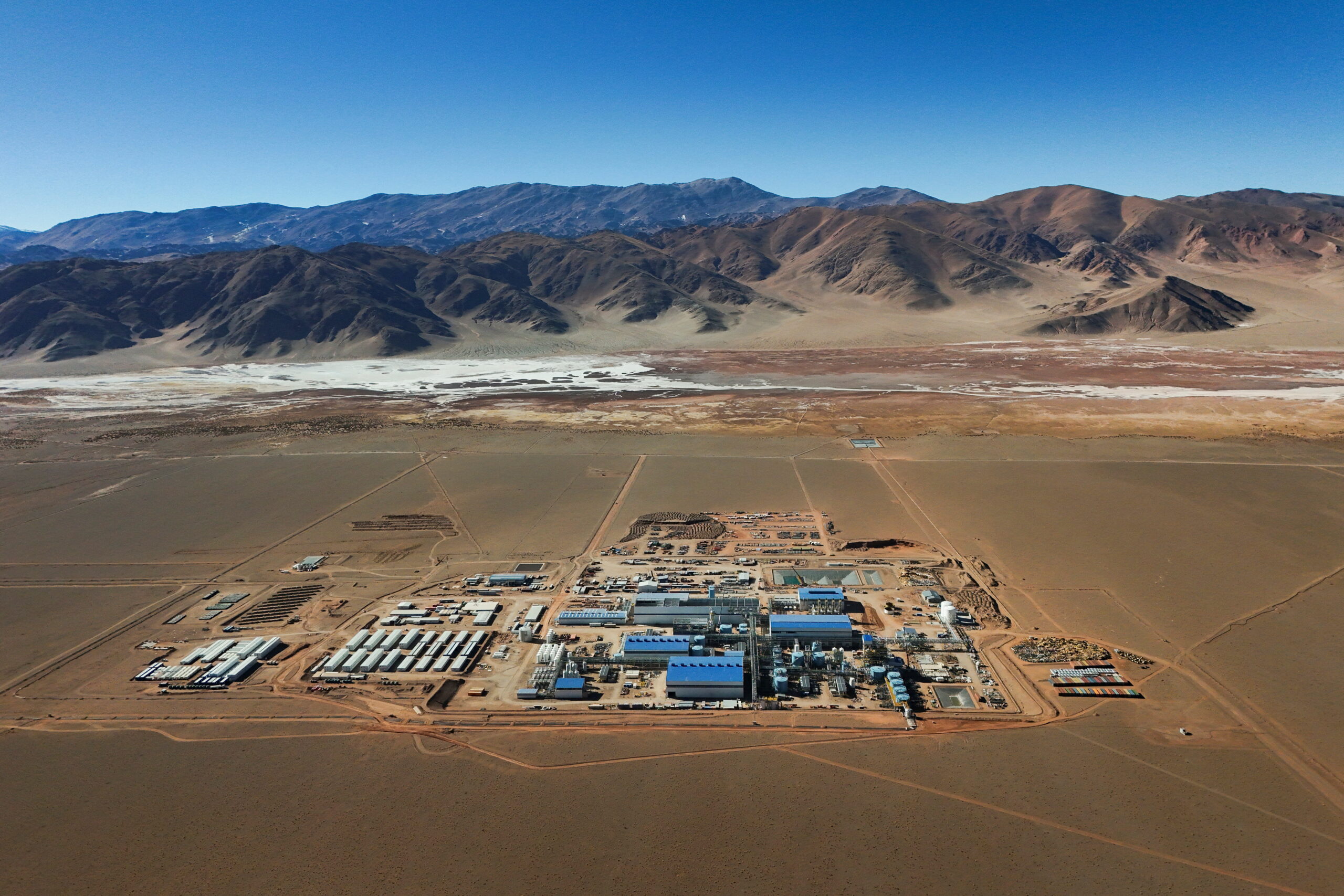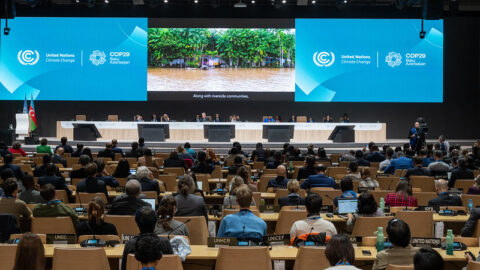Welcome to Carbon Brief’s DeBriefed.
An essential guide to the week’s key developments relating to climate change.
This week
Global extremes
RECORD HEAT: Multiple countries experienced record heat this week. Nordic countries were hit by a “truly unprecedented” heatwave, where temperatures reached above 30C in the Arctic Circle and Finland endured three straight weeks with 30C heat, its longest heat streak in records going back to 1961, said the Guardian. Reuters reported that the United Arab Emirates (UAE) is facing “surging temperatures this summer”, following its hottest spring ever.
FIRE WEATHER: Some 81 million Americans were under air quality alerts as hundreds of wildfires burned across Canada and parts of the US, reported the Guardian. Meanwhile, a “massive” wildfire in California has “become the biggest blaze in the state so far this year” amid an intensifying heatwave, reported the Associated Press.
TORRENTIAL RAIN: A “torrent of mud” has killed at least four people in the northern Himalayan state of Uttarakhand, Reuters reported. According to the Times of India, “more than one cloudburst” hit the high-altitude district of Uttarkashi on Tuesday, triggering flash floods. It added that cloudburst risks in the Himalayan region are “projected to increase with climate change”. Meanwhile, Taiwan News said that “torrential rain in central and southern Taiwan over several days has left three dead, four missing, 49 injured and prompted 85 rescues”. Flash floods in a Myanmar-China “border town” have killed six people, according to the Straits Times.
Around the world
- COP30 CHAOS: After significant delays and pressure from a UN committee, Brazil has finally launched the official accommodation platform for COP30, Climate Home News reported. It added that “significant markups and sky-high prices remained”.
- MORE TARIFFS: Donald Trump has increased tariffs on imports from India to 50% as “punishment” for the country buying Russian oil, the New York Times reported.
- CORAL BLEACHING: The Guardian said that the Great Barrier Reef suffered its biggest annual drop in live coral since 1986 in two out of the three areas that are monitored by scientists..
- ENDANGERED: Top scientific advisers in the US have announced that they will “conduct an independent, fast-track review of the latest climate science” following the Trump administration’s move to repeal the “endangerment finding”, the scientific basis for federal climate regulations, Inside Climate News reported.
10,000
The number of glaciers in the Indian Himalayas that are “receding due to a warming climate”, according to Reuters.
Latest climate research
- Ecosystem restoration should be “pursued primarily” for biodiversity, supporting livelihoods and resilience of ecosystem services, as “climate mitigation potential will vary” | Nature Geoscience
- Attendees at the 2024 UN Environment Assembly “underestimate global public willingness to contribute 1% of their personal income to climate action” | Communications Earth & Environment
- Urban green spaces can lower temperatures by 1-7C and play a “crucial role in cooling urban environments” | Climate Risk Management
(For more, see Carbon Brief’s in-depth daily summaries of the top climate news stories on Monday, Tuesday, Wednesday, Thursday and Friday.)
Captured
Carbon Brief’s in-depth explainer unpacked the findings of a recent analysis on climate anxiety in more detail. The analysis explored 94 studies, involving more than 170,000 participants across 27 countries, to find out who is more likely to be affected by climate anxiety and what its consequences could be. The analysis suggests that women, young adults and people with “left-wing” political views are more likely to feel climate anxiety.
Spotlight
Heat and fire in France
This week, Carbon Brief explores how France’s media has covered the impacts of recent heatwaves and wildfires.
“We’re used to high temperatures, but we’ve never experienced heat like this [so] early in the year before,” a family member who lives in the Dordogne area of southwest France explained during a recent visit to the country.
Over recent weeks, there have been extreme heatwaves and fires across Europe, which has set new records across the continent, including in France.
France is now gripped once again by extremes. The country is currently experiencing yet another heatwave and this week faced its “largest wildfire in decades”, according to France24.
French climate scientist Dr Olivier Boucher, who is also the CEO of Klima consulting, told Carbon Brief:
“Climate change is already having visible and significant impacts in France. Heatwaves are becoming more frequent, more intense, and are occurring earlier in the season.
“This trend is accompanied by an increased risk of wildfires, particularly in southern regions, though other areas are also increasingly affected, putting the built environment at risk.”
Red alerts
In July, nearly 200 schools closed or partially closed as a result of high temperatures across the country.
Since the start of the summer, water reserves have been under close surveillance and multiple areas are facing water restrictions as a result of drought.
These water restrictions can include the use of tap water and violations can incur fines of €1,500 (£1,300). According to Le Monde, more than a third of the country is under drought alerts.
France has also experienced a “devastating summer” for fire outbreaks, according to FranceInfo. Traditional firework displays celebrating France’s Bastille day on 14 July were cancelled across the country due to forest fire risks, said Le Monde.

On 4 August, the local area of Aude, situated in the south-east, was placed under a red alert for forest fire risks.
Since then, there have been record-breaking fires in the region. BBC News reported that fires have “scorched an area larger than Paris”. The broadcaster added that the country’s prime minister, François Bayrou, linked the fires to global warming and drought, describing them as a “catastrophe on an unprecedented scale”.
Needing to adapt
Le Point explained how heatwaves impact grape vines and how winemakers have adapted their growing techniques by leaving more leaves on vines to protect the grapes from getting burned by the sun. However, it added that, “in the long run, it is necessary to think about more long-term modifications of viticulture”.
FranceInfo told the story of winegrowers losing their crops, worth millions of euros, in the recent fires in southern France, adding that it is “a real economic disaster for farmers affected by the flames”.
Le Monde interviewed French geographer Dr Magali Reghezza-Zitt, who described the nation’s preparations for dealing with climate change as inadequate. She told the newspaper:
“The gap between what needs to be done and the pace at which climate change is accelerating grows wider each year.”
Boucher added to Carbon Brief:
“All economic sectors are impacted by climate change, with agriculture among the most vulnerable. As the warming trend is projected to continue over the coming decades, adaptation will be essential – both through the climate-proofing of infrastructure and through changes in practices across sectors.”
Watch, read, listen
‘GRASSROOTS ALLIANCE’: A Deutsche Welle documentary explained how unions, activists and the India Meteorological Department have joined forces to protect Delhi’s informal workers from extreme heat.
NEW RULES: A Bloomberg article said that South Africa “will seek jail time, fines and higher taxes for breaches of proposed rules to govern carbon emissions” as part of new efforts to reduce the country’s dependency on coal.
SUSTAINABLE AI?: As the AI race intensifies, the Financial Times investigated if data centers can “ever truly be green”.
Coming up
- 5-14 August: Resumed talks on a global plastics treaty, Geneva, Switzerland
- 10-15 August: Ecological Society of America annual meeting | Baltimore, US
- 13-15 August: African Union-AIP water investment summit 2025 | Cape Town, South Africa
- 15 August: China Environmental Science Youth Academic Conference | Changsha, China
Pick of the jobs
- Save the Children, senior climate advisor | Salary: £61,500-£69,200. Location: London
- Irish Independent, environmental correspondent | Salary: Unknown. Location: Dublin
- Ember, interim managing director | Salary: £89,000-£100,000. Location: Remote
- British Antarctic Survey, seabird remote sensing data analyst | Salary: £41,344-£45,479. Location: Cambridge, UK
DeBriefed is edited by Daisy Dunne. Please send any tips or feedback to debriefed@carbonbrief.org.
This is an online version of Carbon Brief’s weekly DeBriefed email newsletter. Subscribe for free here.
The post DeBriefed 8 August 2025: Arctic heatwave; Climate anxiety deep-dive; France’s wildfire crisis appeared first on Carbon Brief.
DeBriefed 8 August 2025: Arctic heatwave; Climate anxiety deep-dive; France’s wildfire crisis
Climate Change
Efforts to green lithium extraction face scrutiny over water use
Mining companies are showcasing new technologies which they say could extract more lithium – a key ingredient for electric vehicle (EV) batteries – from South America’s vast, dry salt flats with lower environmental impacts.
But environmentalists question whether the expensive technology is ready to be rolled out at scale, while scientists warn it could worsen the depletion of scarce freshwater resources in the region and say more research is needed.
The “lithium triangle” – an area spanning Argentina, Bolivia and Chile – holds more than half of the world’s known lithium reserves. Here, lithium is found in salty brine beneath the region’s salt flats, which are among some of the driest places on Earth.
Lithium mining in the region has soared, driven by booming demand to manufacture batteries for EVs and large-scale energy storage.
Mining companies drill into the flats and pump the mineral-rich brine to the surface, where it is left under the sun in giant evaporation pools for 18 months until the lithium is concentrated enough to be extracted.
The technique is relatively cheap but requires vast amounts of land and water. More than 90% of the brine’s original water content is lost to evaporation and freshwater is needed at different stages of the process.
One study suggested that the Atacama Salt Flat in Chile is sinking by up to 2 centimetres a year because lithium-rich brine is being pumped at a faster rate than aquifers are being recharged.
Lithium extraction in the region has led to repeated conflicts with local communities, who fear the impact of the industry on local water supplies and the region’s fragile ecosystem.
The lithium industry’s answer is direct lithium extraction (DLE), a group of technologies that selectively extracts the silvery metal from brine without the need for vast open-air evaporation ponds. DLE, it argues, can reduce both land and water use.
Direct lithium extraction investment is growing
The technology is gaining considerable attention from mining companies, investors and governments as a way to reduce the industry’s environmental impacts while recovering more lithium from brine.
DLE investment is expected to grow at twice the pace of the lithium market at large, according to research firm IDTechX.
There are around a dozen DLE projects at different stages of development across South America. The Chilean government has made it a central pillar of its latest National Lithium Strategy, mandating its use in new mining projects.
Last year, French company Eramet opened Centenario Ratones in northern Argentina, the first plant in the world to attempt to extract lithium solely using DLE.
Eramet’s lithium extraction plant is widely seen as a major test of the technology. “Everyone is on the edge of their seats to see how this progresses,” said Federico Gay, a lithium analyst at Benchmark Mineral Intelligence. “If they prove to be successful, I’m sure more capital will venture into the DLE space,” he said.
More than 70 different technologies are classified as DLE. Brine is still extracted from the salt flats but is separated from the lithium using chemical compounds or sieve-like membranes before being reinjected underground.
DLE techniques have been used commercially since 1996, but only as part of a hybrid model still involving evaporation pools. Of the four plants in production making partial use of DLE, one is in Argentina and three are in China.
Reduced environmental footprint
New-generation DLE technologies have been hailed as “potentially game-changing” for addressing some of the issues of traditional brine extraction.
“DLE could potentially have a transformative impact on lithium production,” the International Lithium Association found in a recent report on the technology.
Firstly, there is no need for evaporation pools – some of which cover an area equivalent to the size of 3,000 football pitches.
“The land impact is minimal, compared to evaporation where it’s huge,” said Gay.


The process is also significantly quicker and increases lithium recovery. Roughly half of the lithium is lost during evaporation, whereas DLE can recover more than 90% of the metal in the brine.
In addition, the brine can be reinjected into the salt flats, although this is a complicated process that needs to be carefully handled to avoid damaging their hydrological balance.
However, Gay said the commissioning of a DLE plant is currently several times more expensive than a traditional lithium brine extraction plant.
“In theory it works, but in practice we only have a few examples,” Gay said. “Most of these companies are promising to break the cost curve and ramp up indefinitely. I think in the next two years it’s time to actually fulfill some of those promises.”
Freshwater concerns
However, concerns over the use of freshwater persist.
Although DLE doesn’t require the evaporation of brine water, it often needs more freshwater to clean or cool equipment.
A 2023 study published in the journal Nature reviewed 57 articles on DLE that analysed freshwater consumption. A quarter of the articles reported significantly higher use of freshwater than conventional lithium brine mining – more than 10 times higher in some cases.
“These volumes of freshwater are not available in the vicinity of [salt flats] and would even pose problems around less-arid geothermal resources,” the study found.
The company tracking energy transition minerals back to the mines
Dan Corkran, a hydrologist at the University of Massachusetts, recently published research showing that the pumping of freshwater from the salt flats had a much higher impact on local wetland ecosystems than the pumping of salty brine. “The two cannot be considered equivalent in a water footprint calculation,” he said, explaining that doing so would “obscure the true impact” of lithium extraction.
Newer DLE processes are “claiming to require little-to-no freshwater”, he added, but the impact of these technologies is yet to be thoroughly analysed.
Dried-up rivers
Last week, Indigenous communities from across South America held a summit to discuss their concerns over ongoing lithium extraction.
The meeting, organised by the Andean Wetlands Alliance, coincided with the 14th International Lithium Seminar, which brought together industry players and politicians from Argentina and beyond.
Indigenous representatives visited the nearby Hombre Muerto Salt Flat, which has borne the brunt of nearly three decades of lithium extraction. Today, a lithium plant there uses a hybrid approach including DLE and evaporation pools.
Local people say the river “dried up” in the years after the mine opened. Corkran’s study linked a 90% reduction in wetland vegetation to the lithium’s plant freshwater extraction.
Pia Marchegiani, of Argentine environmental NGO FARN, said that while DLE is being promoted by companies as a “better” technique for extraction, freshwater use remained unclear. “There are many open questions,” she said.
AI and satellite data help researchers map world’s transition minerals rush
Stronger regulations
Analysts speaking to Climate Home News have also questioned the commercial readiness of the technology.
Eramet was forced to downgrade its production projections at its DLE plant earlier this year, blaming the late commissioning of a crucial component.
Climate Home News asked Eramet for the water footprint of its DLE plant and whether its calculations excluded brine, but it did not respond.
For Eduardo Gigante, an Argentina-based lithium consultant, DLE is a “very promising technology”. But beyond the hype, it is not yet ready for large-scale deployment, he said.
Strong regulations are needed to ensure that the environmental impact of the lithium rush is taken seriously, Gigante added.
In Argentina alone, there are currently 38 proposals for new lithium mines. At least two-thirds are expected to use DLE. “If you extract a lot of water without control, this is a problem,” said Gigante. “You need strong regulations, a strong government in order to control this.”
The post Efforts to green lithium extraction face scrutiny over water use appeared first on Climate Home News.
Efforts to green lithium extraction face scrutiny over water use
Climate Change
Maryland’s Conowingo Dam Settlement Reasserts State’s Clean Water Act Authority but Revives Dredging Debate
The new agreement commits $340 million in environmental investments tied to the Conowingo Dam’s long-term operation, setting an example of successful citizen advocacy.
Maryland this month finalized a $340 million deal with Constellation Energy to relicense the Conowingo Dam in Cecil County, ending years of litigation and regulatory uncertainty. The agreement restores the state’s authority to enforce water quality standards under the Clean Water Act and sets a possible precedent for dozens of hydroelectric relicensing cases nationwide expected in coming years.
Climate Change
A Michigan Town Hopes to Stop a Data Center With a 2026 Ballot Initiative
Local officials see millions of dollars in tax revenue, but more than 950 residents who signed ballot petitions fear endless noise, pollution and higher electric rates.
This is the second of three articles about Michigan communities organizing to stop the construction of energy-intensive computing facilities.
A Michigan Town Hopes to Stop a Data Center With a 2026 Ballot Initiative
-
Climate Change2 years ago
Spanish-language misinformation on renewable energy spreads online, report shows
-
Climate Change2 months ago
Guest post: Why China is still building new coal – and when it might stop
-
Climate Change Videos2 years ago
The toxic gas flares fuelling Nigeria’s climate change – BBC News
-

 Greenhouse Gases1 year ago
Greenhouse Gases1 year ago嘉宾来稿:满足中国增长的用电需求 光伏加储能“比新建煤电更实惠”
-
Greenhouse Gases2 months ago
Guest post: Why China is still building new coal – and when it might stop
-

 Climate Change1 year ago
Climate Change1 year ago嘉宾来稿:满足中国增长的用电需求 光伏加储能“比新建煤电更实惠”
-

 Carbon Footprint2 years ago
Carbon Footprint2 years agoUS SEC’s Climate Disclosure Rules Spur Renewed Interest in Carbon Credits
-
Renewable Energy3 months ago
US Grid Strain, Possible Allete Sale








